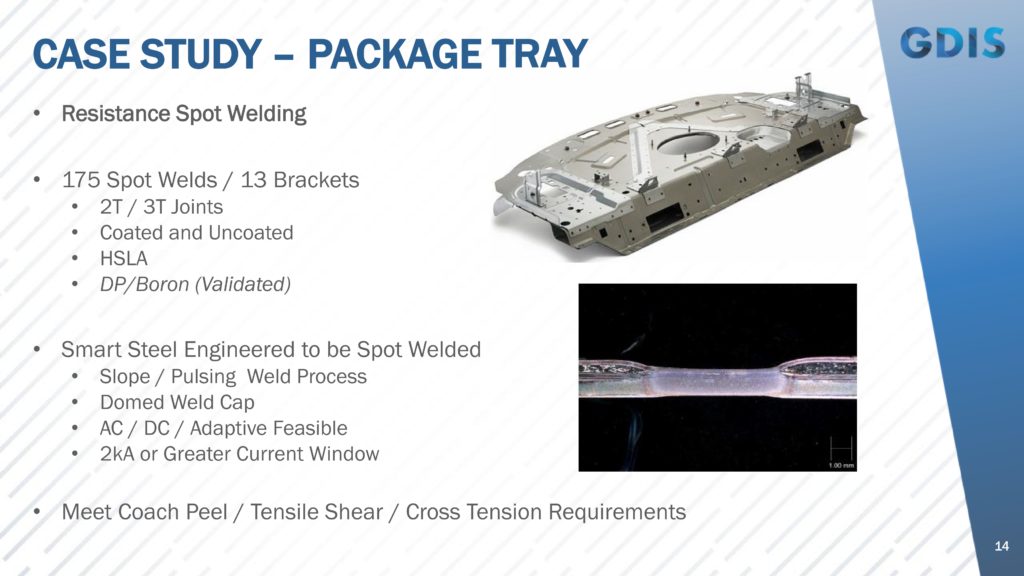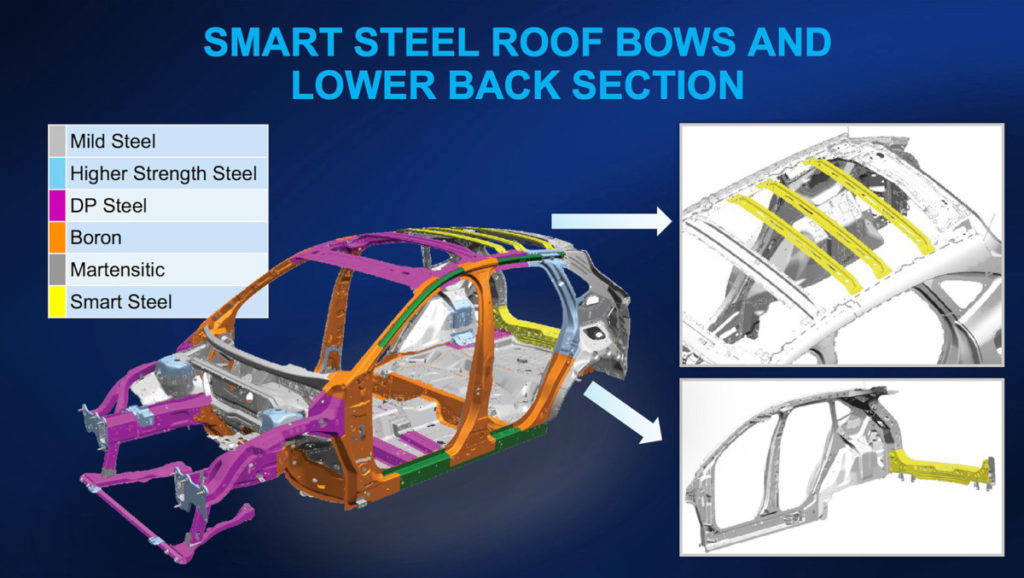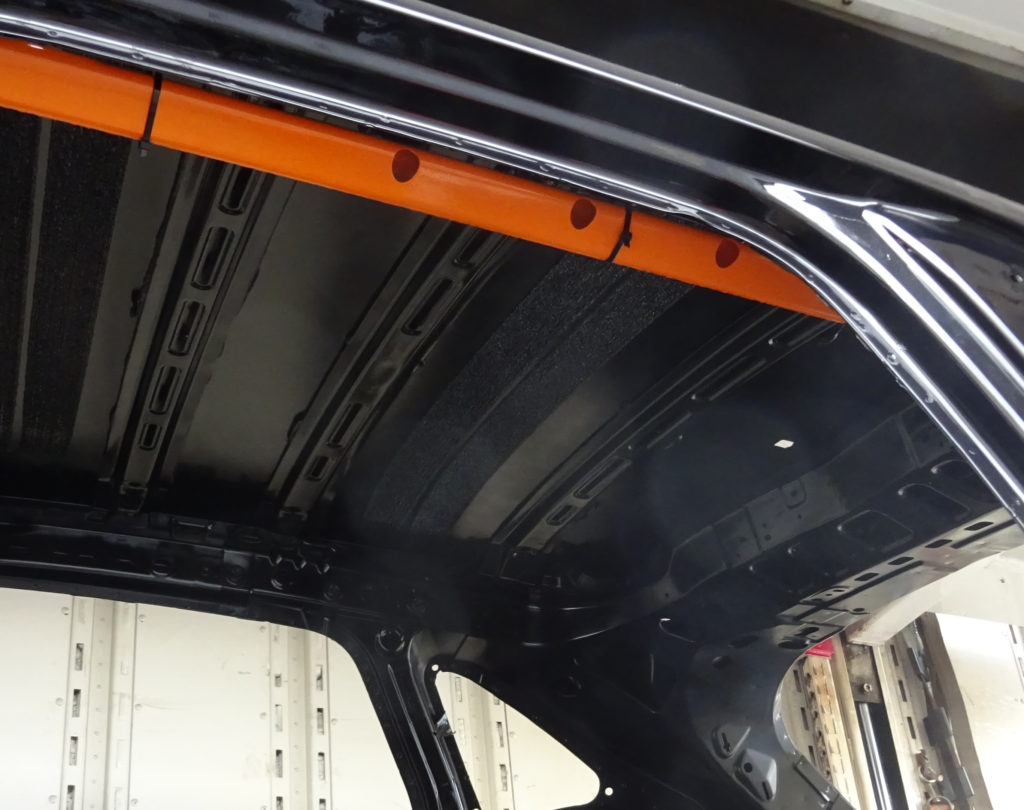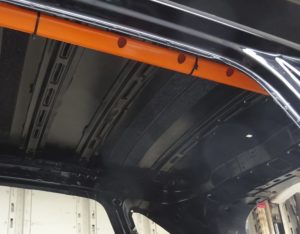
MSC: ‘Smart Steel’ cuts mass, improves stiffness, NVH, can be spot-welded in factory
By onMarket Trends | Repair Operations | Technology
The “Smart Steel” found in three 2020 Ford Escape roof bows saved 40 percent weight over a standard roof bow set while permitting traditional factory welding, Mike Kozak of Ford body structures applications said this spring.
Kozak and Smart Steel manufacturers Material Science Corporation at the May 15 Great Designs in Steel described a substance which seems likely to appear in more new vehicle bodies. Besides the three roof bows, Ford also used the substrate for the lower back of the Escape, behind the bottom of the tailgate.
Kozak said the Smart Steel on the roof bows involved two thin steel outer layers sandwiching a steel-fiber-reinforced composite. MSC called the core’s fibers conductive, and Kozak said that inner structure permitted traditional resistance spot welding in a Ford plant — there was no need to switch out equipment.
Hopefully, this means such steels could be installed with a collision repairer’s squeeze-type resistance spot welder if the welder carries the correct specs. (Obviously, you’ll have to check the actual Ford repair procedures once the Escape goes on sale to verify that.)
Ford’s coupling of parts within tooling allowed it to get the cost of using the lighter but more expensive steel to a “very reasonable” cost below $3 per kilogram, Kozak said. MSC sales and engineering Vice President Matt Murphy said the company’s goal is costing an OEM $2 per each pound saved, and Smart Steel’s cost of $5 per kg “fits very nicely into that equation.”
MSC sales and engineering Vice President Matt Murphy said the core is extruded in sheets and bonded to the two steel layers. A study showed the substance’s recyclability was “very consistent” with normal steel, he said.
MSC’s Great Designs in Steel presentation said the Smart Steel could typically cut 20-35 percent of mass, came in a stampable coil, and was “Cleaner / E-coat / Paint Compatible.” A slide argued that the substrate made better sense to an OEM than lightweighting with aluminum.
The presentation described the material as a substitute for “Non-High Strength Steel” and “Low Carbon Steel” in a vehicle body.
A case study involving a package tray found the material radiated 5-10 decibels less noise and demonstrated greater stiffness compared to a traditional steel; the MSC presentation suggested the substrate could be useful in a part receiving vibrations from items such as speakers.
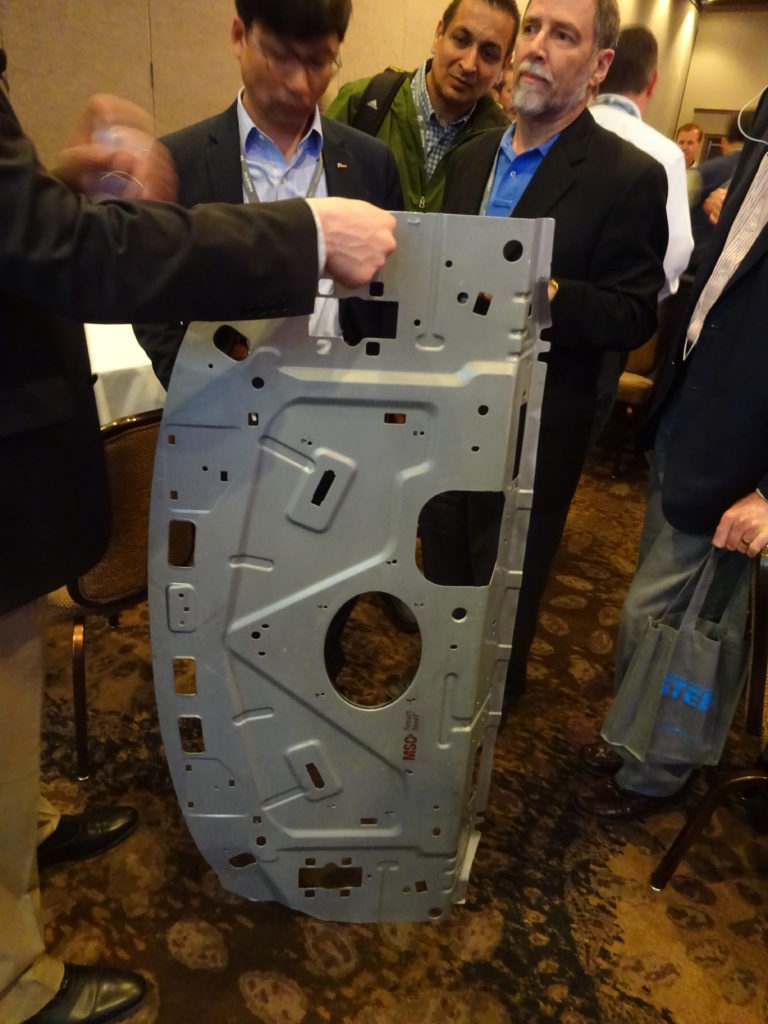
Materials Science Corporation performed a case study of this “Smart Steel” package tray. (John Huetter/Repairer Driven News)
The baseline low-carbon steel package tray studied by MSC weighed 3.7 kg (8.16 pounds) and measured 0.66 mm thick. MSC’s Smart Steel version was 0.74 mm thick but only 2.9 kg (6.39 pounds), a 22 percent mass reduction. Each of the Smart Skills skins contributed only around 0.19 mm of that thickness, according to Murphy. (He said the two skins can have different thicknesses if the OEM wants.)
The original tray had been joined by 175 spot welds and 13 brackets to a variety of steels.
MSC product development director Bryan Tullis said the company had validated its Smart Steel version could also be welded to dual-phase and boron steel as well as lower-strength steels. AC, DC and adaptive welding had all been vetted, and the company had proven it received a 2-kiloamp or greater current window, he said.
Tullis said MSC does recommend an upslope in pulsing and using dome weld caps.
The 0.74 mm Smart Steel joined to a 0.9 mm high-strength, low-alloy 340 steel needed a 1.4 kiloNewton requirement in tensile shear, and Smart Steel was able to deliver that, according to Tullis and his presentation.
Murphy said Smart Steel had seen success with projection and drawn-arc welding — but not MIG arc welding. No special venting was installed for production welding applications this year, he said.
In terms of formability, the Smart Steel package tray stamped on production tools came in “pretty close” to the CAD nominal dimensions, Tullis said. He said the company stamped “many, many, many” parts and proved the material could be stamped. Murphy said the Escape’s roof bows had 30 percent elongation.
MSC has learned that the three-layer material needs a tighter trim clearance, typically 5-10 percent, but if the die gets through all three layers, you’ll produce “nice parts,” according to Tullis. The Smart Steel also “does like stretch,” and providing that can minimize springback, he said.
Murphy said MSC’s experience found the core’s thickness didn’t affect formability.
“The dominant force is the steel,” Murphy said. The core had greater elongation, and while it would eventually break, the steel would fracture first, he said.
On the whole, Smart Steel offered a “great opportunity” to use more steel and cut mass, Tullis said.
In terms of corrosion resistance, Murphy said MSC for now is focusing on uncoated applications. However, the presentation did suggest external Smart Steel steel bumper fascias as a use case, and Murphy said MSC had success chrome-plating and painting the substrate. MSC is also testing zinc-coated Smart Steel, he said.
Murphy said MSC also had received many requests for Smart Steel versions of external parts such as hoods, and the company was “very focused” on that application. He said such large parts would use a lot of Smart Steel, so the cost to save weight “goes up dramatically” on those exterior panels. Murphy didn’t know if such exterior panels could have a dent repaired.
Asked about repairability after a collision, Murphy argued that if a roof bow were damaged by a crash, the vehicle was probably totaled, predicting that for the applications the company is considering, “they’re not gonna be repaired.”
Energy flow during less severe collisions could present instances where the vehicle isn’t a total loss but the roof bows or other Smart Steel parts are affected by the crash. It’ll be interesting to see what Ford and other OEM engineers conclude can or can’t be done on those parts.
For example, General Motors’ steel matrix treats laminated steel (the closest thing we could think of to the Smart Steel) permits only spot-welding and cold repair if nothing’s kinked. However, the OEM forbids any heat application to the laminated steel as well as MIG welding and brazing. (As always, check the specific GM repair procedures for your specific vehicle in case the OEM made an exception to these general guidelines.)
More information:
“MSC SMART STEEL® ENABLES LIGHTWEIGHT VEHICLE BODY STRUCTURES”
Materials Science Corporation via Steel Market Development Institute, May 15, 2019
Material Sciences Corporation Smart Steel webpage
Ford OEM repair procedures website
General Motors OEM repair procedure website
Images:
The “Smart Steel” roof bows in the 2020 Ford Escape are shown. (John Huetter/Repairer Driven News)
Materials Science Corporation performed a case study of a “Smart Steel” package tray. It found the substance could be spot-welded. (Provided by Materials Science Corporation via Great Designs in Steel)
Materials Science Corporation performed a case study of this “Smart Steel” package tray. (John Huetter/Repairer Driven News)
Ford on April 2, 2019, revealed the next generation of its No. 2 seller Escape, declaring it to be more than 200 pounds lighter “due in part to the extensive use of high-strength, lightweight steel.” “Ultra-high-strength steel 3D-rolled tubes run up each A-pillar and along the rooflines, and high-strength boron steel solidifies the subframe,” Ford wrote on a 2020 Escape microsite. (Provided by Ford)

